If you are in the right place and at the right time, you might find yourself among the dragonflies and damselflies as they emerge from their natal coastal ponds and wetlands in the summer. You’ll see them near their freshwater habitats — if you are lucky and if you don’t blink — assembling among birds, butterflies, and even people, from now through fall.
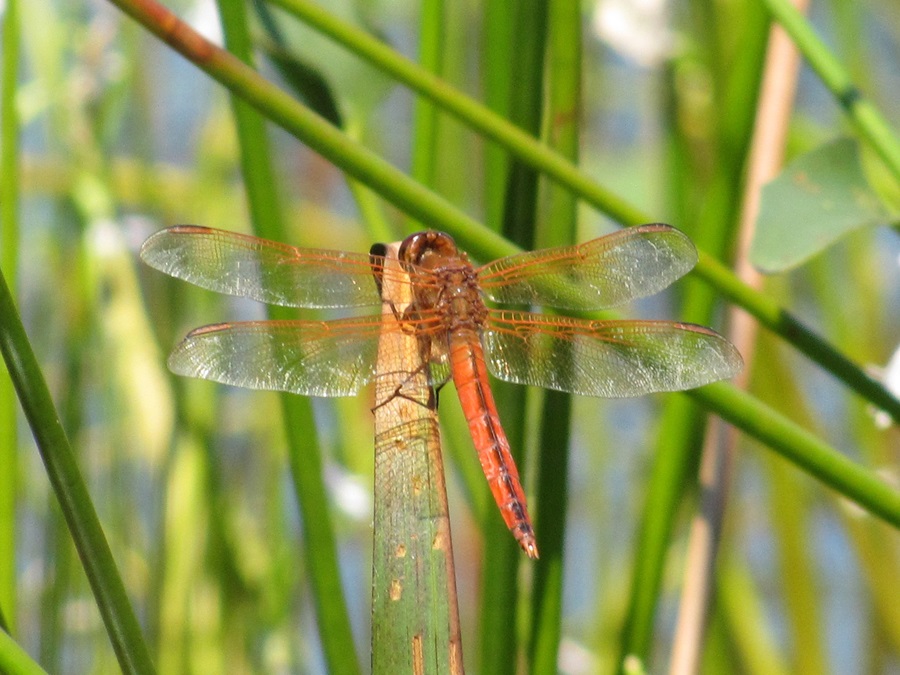
These insects are considered an indicator species for watershed health — that is, their status can give scientists insights into how our aquatic ecosystems are faring. Researchers with the National Park Service are using them to detect levels of heavy metals such as mercury accumulating in freshwater systems, and their populations elsewhere are being looked at to assess the progression of climate change.
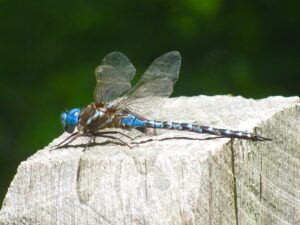
With exotic names as fascinating as their behaviors — names like Ebony Jewelwing, Variable Dancer, and Sedge Sprite — dragonflies invite observation from ordinary nature lovers, too. They are treasured for their colors and their elegance on the wing that cause our imaginations to soar.
Color is one of their most striking attributes. They range from rich magentas to exotic sapphire blues to fiery crimson reds. The insects’ bodies vary from dull to iridescent or even painted with leopard-like spots or tiger stripes. Their wings are often distinctively marked with dazzling spots or bands of color.
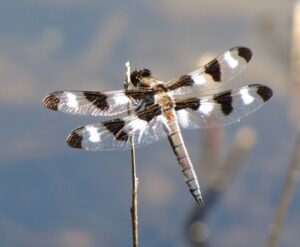
At our ponds during these peak months, it is quite possible to see 15 or 20 different dragonfly species. It’s a good idea to carry close-focusing binoculars and a field guide as well as a camera for capturing their images, making them easier to identify later.
Both dragonflies and damselflies come from the same scientific order, Odonata, and are collectively referred to as odonates or “odes,” meaning “toothed ones.” They have strong serrated jaws that they use to clamp down on their favorite prey, which include (to humans’ relief) gnats and mosquitoes. They are the largest insects we see on Cape Cod, and they come in a dazzling array of colors.

Though people commonly refer to all the odes as dragonflies, careful observers can tell dragonflies and damselflies apart. Adult dragonflies are strong fliers with robust bodies, and, when perched, they hold their slightly unequal pairs of wings straight out from their sides. The four transparent, ultraflexible wings are attached to the thorax of the insect’s body by separate muscles and can be maneuvered independently, lending the insect an extraordinary range of flight options. Dragonflies are magnificent aerialists; they can fly straight up and down, hover like helicopters, and even mate in midair.
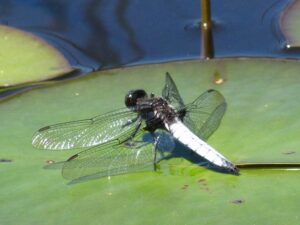
Dragonflies’ eyes are large and possibly the keenest in the insect world — they almost completely cover the insects’ heads. Tens of thousands of lenses in these compound eyes enable nearly 360-degree vision.
Their smaller odonate cousins, the damselflies, on the other hand, are slender, delicate, and weak fliers. They seldom move far from their early-stage habitats, flying at low altitudes and staying within reach of cover vegetation. When at rest, damselflies hold their wings folded or slightly spread over their abdomens in butterfly fashion. Their compound eyes are widely separated on either side of the head. It’s hard to imagine this, but they can see you when they are flying toward you and still see you after they’ve passed and are flying away.
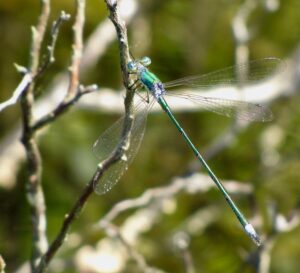
On Cape Cod, there are three families of damselflies (zygoptera), which constitute approximately one-third of our odonate population; they are broad-winged damsels, spreadwings, and pond damsels. Dragonflies (anisoptera) compose the remaining two-thirds of the population and consist of darners, clubtails, emeralds, cruisers, and skimmers.
Odes were some of the first winged insects to evolve. Their ancient lineage dates to the carboniferous period some 300 million years ago — long before the presence of dinosaurs and the appearance of mammals and flowering plants. While modern dragonflies have wingspans of only two to perhaps five inches at most, fossil dragonflies have been found with wingspans of up to two feet.
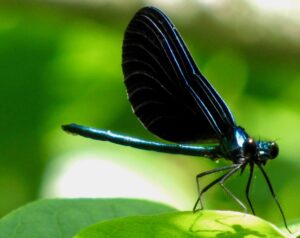
Our local dragonflies and damselflies begin life as larvae (nymphs) on the bottom of wetlands, including coastal ponds. They are slow to develop: many live as flightless nymphs for several years. They are both predators and prey: frogs, fish, turtles, and ducks feast on nymphs, while odonate nymphs can stick out their jaws to capture water beetles, mosquito larvae, tadpoles, and even small fish.
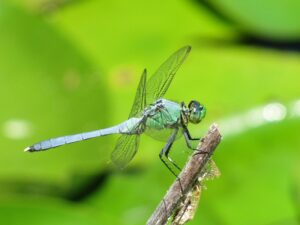
When development is complete, the nymphs emerge. Usually before dawn, perhaps because there are fewer predators then, the nymph crawls from the water onto nearby vegetation, logs, or vertical structures. After several hours the newly emerged adult flies away, leaving behind the nymphal skin or exuviae.
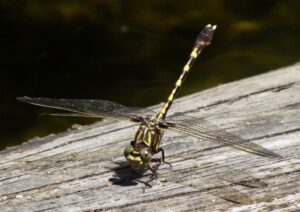
Odes are most active on sunny days and can be found near freshwater ponds, wetlands, or marshy wooded areas and nearby uplands where they spend the majority of their days aloft, hunting and eating before returning to the aquatic environment to mate, deposit eggs, and die.
On the subject of mating: males will patrol near bodies of water to set up and defend territories and await the arrival of females. Males are known to grapple with one another in flight when chasing females. They mate airborne in what appears to be a rough-and-tumble affair. You might recognize the heart-shaped “wheel” formation of mating pairs.

Most dragonflies have short lifespans — they fly for several weeks, up to a few months. Observing them as they hover around our ponds is an act made more magical, perhaps, when you consider that a lifetime for our odes lasts only a single season.
Ken Shea worked in maintenance for the National Park Service for over 30 years and has been a volunteer citizen scientist coordinating dragonfly surveys in the Cape Cod National Seashore since he retired in 2003.



